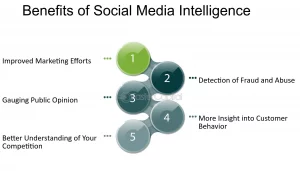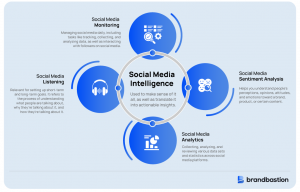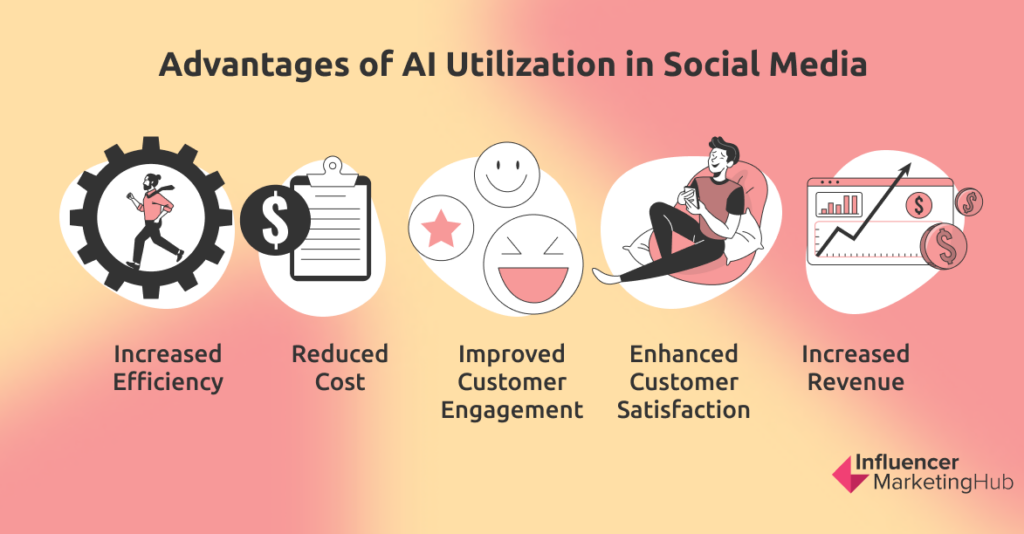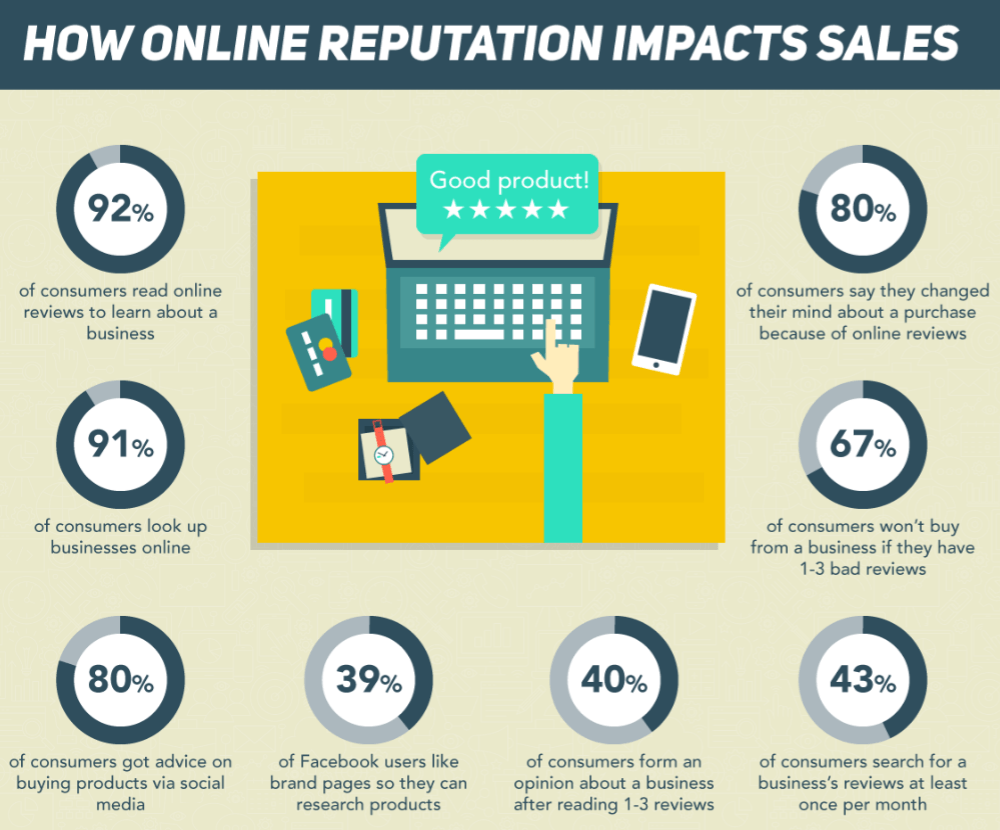In an era where every tweet, post, and comment can make or break a brand’s reputation, mastering the art of social intelligence is no longer optional—it’s essential. Picture this: with over 5.07 billion active social media users worldwide, the digital landscape has become a bustling marketplace where brands vie for attention, loyalty, and trust. But amidst the noise and chaos, how can your brand stand out? How can you navigate the intricacies of social media to not only connect with your audience but also enhance your brand’s reputation?
The role of Social Intelligence in Social Media

Source: fastercapital.com
In the bustling world of social media, where trends and consumer sentiments shift with every viral post, the role of social intelligence emerges as a guiding beacon for brands navigating this digital landscape. At its core, social intelligence encompasses the ability to not just listen, but truly understand the conversations, emotions, and behaviors of audiences across various social platforms.
Understanding the role of social intelligence begins with recognizing its multifaceted nature. It’s not merely about collecting data or monitoring mentions; rather, it involves interpreting these insights through a lens of empathy and context. By deciphering the underlying motivations and sentiments driving online interactions, brands can craft tailored strategies that resonate authentically with their audience.
Why is social intelligence crucial for every brand?
Put simply, it’s the difference between merely existing on social media and truly thriving. In today’s hyper-connected world, consumers expect more than just promotional content—they crave meaningful interactions and authentic connections. By harnessing the power of social intelligence, brands can humanize their digital presence, fostering trust, loyalty, and advocacy among their audience.
Moreover, social intelligence serves as a compass for navigating the ever-changing currents of social media. Whether it’s identifying emerging trends, mitigating potential crises, or optimizing content strategies, brands equipped with social intelligence are better positioned to adapt and succeed in this dynamic landscape. Ultimately, understanding the role of social intelligence isn’t just a competitive advantage—it’s a necessity for brands looking to cultivate a strong, resilient presence in the digital age.
Analyzing Social Media data to enhance Social Intelligence

Source: brandbastion.com
Analyzing social media data is paramount for enhancing social intelligence as it provides valuable insights into audience behaviors, preferences, and sentiments. Here’s how delving into social media metrics, utilizing appropriate tools, and interpreting data can elevate social intelligence and refine communication strategies to better resonate with audiences:
Metrics to monitor:
- Engagement rates: Measure likes, shares, comments, and retweets to gauge audience interaction with your content. High engagement signifies resonance and relevance.
- Sentiment analysis: Assess the tone and emotions conveyed in audience comments and mentions. Understanding sentiment helps gauge audience perception and adjust communication tone accordingly.
- Audience demographics: Determine the age, gender, location, and interests of your audience to tailor content and messaging to suit their preferences.
- Reach and impressions: Track the number of people who have seen your content to gauge its visibility and potential impact.
- Conversion rates: Measure the number of clicks, sign-ups, or purchases generated from social media efforts to assess their effectiveness in driving desired actions.
Tools to use:
- Social media analytics platforms: Utilize platforms like the Palowise Social Listening platform to aggregate and analyze data from multiple social media channels.
- Sentiment analysis tools: Leverage tools to automatically analyze sentiment and identify trends in audience perception.
- Social listening tools: Employ tools to monitor brand mentions, industry trends, and competitor activity, providing valuable insights for strategic decision-making.
- Data visualization tools: Utilize tools to visually represent social media data, making it easier to identify patterns and trends.
Data Interpretation:
- Identifying trends: Analyze data trends to identify popular topics, hashtags, or content formats that resonate with your audience, guiding content creation and curation efforts.
- Tailoring messaging: Use demographic and sentiment data to tailor messaging and content to better align with audience preferences and interests.
- Optimizing content strategy: Adjust content strategy based on engagement and conversion metrics to prioritize high-performing content types and topics.
- Improving customer service: Monitor social media conversations to identify customer pain points and address them promptly, enhancing brand perception and loyalty.
- Crisis management: Detect and address potential crises by monitoring sentiment and addressing concerns before they escalate, safeguarding brand reputation.
By leveraging social media data analytics effectively, brands can gain deeper insights into their audience, refine communication strategies, and foster meaningful connections that drive engagement and loyalty.
Social Intelligence in Social Media: 5 future trends

Source: Maryville University
5 challenges of implementing Social Intelligence in Social Media
 Source: influencermarketinghub.com
Source: influencermarketinghub.com
Challenge #1
Resistance to change: Implementing social intelligence initiatives often faces resistance from within the organization. Some stakeholders may be hesitant to embrace new technologies or methodologies, fearing disruption to existing workflows or roles. Overcoming resistance to change requires effective communication, education, and demonstrating the benefits of social intelligence in driving business outcomes.
Challenge #2
Complexity of data management: Social media platforms generate vast amounts of data in various formats, making data management a significant challenge. Organizing, analyzing, and extracting actionable insights from this data requires robust data management systems and skilled data analysts. Additionally, ensuring data accuracy, relevance, and compliance with privacy regulations adds another layer of complexity to the process.
Challenge #3
Resource allocation: Successfully implementing social intelligence initiatives requires dedicated resources, including personnel, technology, and budget. Many organizations may struggle to allocate sufficient resources due to competing priorities or limited understanding of the value of social intelligence. Securing buy-in from senior leadership and advocating for adequate resource allocation is essential for long-term success.
Challenge #4
Scale and consistency across platforms: Maintaining consistency and scalability across different social media platforms poses a challenge for organizations with a presence on multiple channels. Each platform has its own unique audience demographics, content formats, and engagement metrics, requiring tailored strategies for effective social intelligence. Balancing the need for platform-specific tactics with overarching brand consistency can be demanding but crucial for maximizing impact.
Challenge #5
Maintaining authenticity: In the age of social media, authenticity is paramount for building trust and credibility with audiences. However, leveraging social intelligence to inform content and engagement strategies runs the risk of coming across as inauthentic or overly calculated. Striking the right balance between data-driven insights and genuine human interaction requires careful consideration and a deep understanding of audience preferences and expectations.
By addressing these challenges head-on and implementing strategies to mitigate them, organizations can harness the power of social intelligence to drive meaningful engagement, enhance brand reputation, and achieve their business objectives in the dynamic world of social media.
Measuring the impact of Social Intelligence in Social Media

Source: influencermarketinghub.com
- Engagement rate success: Increased engagement metrics, such as likes, shares, comments, and retweets, indicate that social intelligence initiatives are resonating with the audience and driving meaningful interactions. Utilize social media analytics tools to track changes in engagement metrics over time. Compare performance before and after implementing social intelligence strategies to assess impact.
- Sentiment analysis success: Positive sentiment trends across social media mentions and comments demonstrate improved audience perception and satisfaction with the brand. Utilize sentiment analysis tools to monitor changes in sentiment over time. Track the percentage of positive, negative, and neutral mentions to gauge progress.
- Customer satisfaction scores success: Higher customer satisfaction scores, measured through surveys or feedback mechanisms, indicate that social intelligence initiatives are effectively meeting customer needs and expectations. Implement regular customer satisfaction surveys or feedback forms to collect data on customer sentiment and satisfaction levels. Analyze trends and changes in satisfaction scores over time to measure the impact of social intelligence efforts.
- Brand loyalty and advocacy success: Increased brand loyalty and advocacy, evidenced by higher rates of repeat purchases, referrals, and positive reviews, indicate that social intelligence initiatives are fostering stronger connections with the audience. Track metrics such as customer retention rates, referral program participation, and online reviews using tools and customer relationship management (CRM) software. Monitor changes in these metrics to assess the impact of social intelligence on brand loyalty and advocacy.
- Return on Investment (ROI) success: Positive ROI from social intelligence initiatives, demonstrated through increased sales, lead generation, or cost savings, indicates that the investment in social intelligence is delivering tangible business results. Use tracking tools integrated with social media platforms or web analytics tools to attribute conversions and revenue directly to social intelligence efforts. Calculate ROI by comparing the cost of social intelligence initiatives to the revenue generated as a result.
By measuring these key metrics and tracking progress over time, organizations can effectively evaluate the impact of their social intelligence initiatives on social media and make data-driven decisions to optimize strategies for improved engagement, satisfaction, and brand loyalty.

Source: sprinklr.com
How Social Intelligence in Social Media can affect brand reputation
Social intelligence plays a pivotal role in shaping brand reputation in the dynamic realm of social media. Here’s how adept handling of social interactions can influence public perception and trust:
- Immediate response to crisis: Social intelligence enables brands to swiftly detect and respond to potential crises before they escalate. For instance, when a major airline experiences a technical issue causing flight delays, prompt acknowledgment and updates via social media can mitigate customer frustration and preserve brand reputation.
- Authentic engagement: Engaging authentically with audiences fosters trust and loyalty. For example, L’Oréal that actively listens to customer feedback on social media and incorporates it into product development demonstrates a commitment to customer satisfaction, enhancing brand reputation.
- Reputation management: Social intelligence allows brands to monitor and manage their online reputation effectively. Let’s say an FMCG company gets a negative review on social media. By publicly acknowledging the customer’s feedback and offering a solution to their problem, the company shows it’s accountable for its actions. This can help lessen the damage to the brand’s reputation. In fact, this approach has been used by Nestle.
- Crisis prevention and prediction: By analyzing social media data, brands can identify emerging trends and potential issues before they become full-blown crises. For instance, a retail company monitoring social media conversations detects dissatisfaction among customers regarding a specific product feature. Addressing the issue proactively can prevent a larger backlash and preserve brand reputation.
- Building brand advocacy: Social intelligence helps identify brand advocates and influencers who can amplify positive messages and recommendations. For example, a software company engaging with industry influencers and leveraging user-generated content to showcase positive experiences can build brand advocacy and enhance reputation.
In essence, adept handling of social interactions through social intelligence can significantly impact brand reputation by fostering trust, authenticity, and positive engagement. By proactively listening, engaging, and responding to customers on social media, brands can strengthen their reputation and build lasting relationships with their audience.
5 benefits for Brand Reputation

Source: webfx.com
- Enhanced customer relationships: Social intelligence enables brands to actively listen to customer feedback, preferences, and concerns across social media platforms. By engaging authentically and responding promptly to customer inquiries and feedback, brands can foster stronger relationships with their audience. This proactive approach demonstrates attentiveness and empathy, leading to increased customer satisfaction and loyalty.
- Increased brand loyalty: By leveraging social intelligence to tailor content, offers, and interactions to meet the needs and preferences of their audience, brands can cultivate deeper connections and foster brand loyalty. Understanding customer sentiments and preferences allows brands to deliver personalized experiences, strengthening the emotional bond between the brand and its customers.
- Proactive crisis management: Social intelligence enables brands to detect and address potential crises before they escalate. By monitoring social media conversations and sentiment in real-time, brands can identify emerging issues, negative feedback, or misinformation and respond promptly to mitigate the impact on brand reputation. Proactive crisis management builds trust and demonstrates transparency, preserving brand credibility even in challenging situations.
- Competitive advantage: Brands that leverage social intelligence gain valuable insights into market trends, competitor strategies, and consumer behavior. By staying ahead of the curve and adapting their strategies based on social insights, brands can differentiate themselves from competitors and position themselves as industry leaders. This proactive approach to market intelligence gives brands a competitive edge and enhances their reputation as innovative and customer-focused.
- Improved business outcomes: Ultimately, leveraging social intelligence for brand reputation management leads to tangible business outcomes. By strengthening customer relationships, increasing brand loyalty, and effectively managing crises, brands can drive customer acquisition, retention, and advocacy. Positive brand reputation translates into increased sales, higher customer lifetime value, and sustainable business growth, demonstrating the tangible impact of proactive social intelligence initiatives.
Unlock the code to brand success with Palowise: It’s All About Social Intelligence
Embarking on the journey of incorporating social intelligence into your social media strategies with Palowise is a seamless process. Our platform offers easy integration with your existing tools and workflows, ensuring a smooth transition and minimal disruption to your operations. With intuitive interfaces and comprehensive support resources, Palowise empowers you to harness the full potential of social intelligence without the need for extensive technical expertise.
Furthermore, Palowise doesn’t just provide tools – we offer unparalleled support every step of the way. From onboarding assistance to ongoing guidance and training, our dedicated team is committed to your success. Whether you have questions, need advice, or encounter challenges, Palowise is here to provide the support and expertise you need to maximize the impact of social intelligence on your brand.
By adopting smarter, more empathetic social media practices with Palowise, you’re not just investing in better engagement or increased brand visibility – you’re investing in tangible ROI. The ability to understand your audience on a deeper level, anticipate their needs, and respond with empathy and authenticity leads to higher customer satisfaction, increased loyalty, and ultimately, greater business success. With Palowise, the potential ROI from adopting social intelligence-driven practices is not just a possibility – it’s a certainty.
Don’t miss out on the opportunity to transform your brand’s social media strategy and unlock new levels of success with Palowise. Get started today and discover the difference social intelligence can make for your brand.


